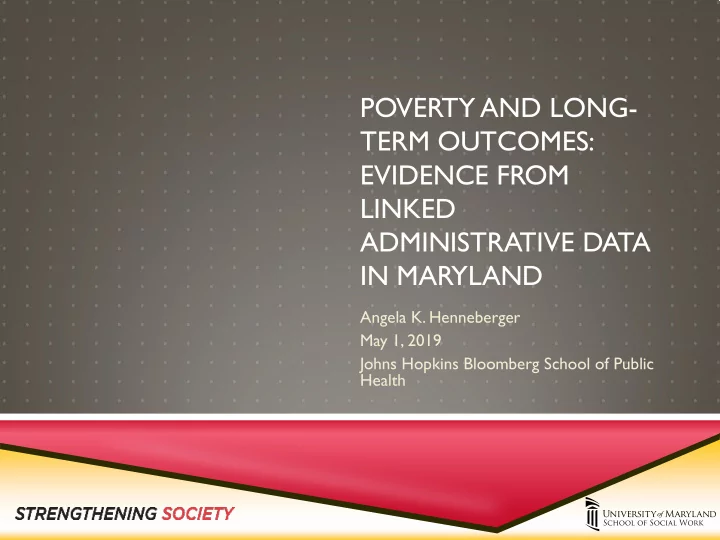

POVERTY AND LONG- TERM OUTCOMES: EVIDENCE FROM LINKED ADMINISTRATIVE DATA IN MARYLAND Angela K. Henneberger May 1, 2019 Johns Hopkins Bloomberg School of Public Health
CO-AUTHORS AND ACKNOWLEDGEMENT Bess Rose Dawnsha Mushonga Boyoung Nam Alison Preston The authors are grateful for the data, technical, and research support provided by the Maryland Longitudinal Data System (MLDS) Center and its agency partners. The views and opinions expressed are those of the authors and do not necessarily represent the views of the MLDS Center or its agency partners.
GROWING USE OF ADMINISTRATIVE DATA FOR RESEARCH Big data, including administrative data systems, are increasingly being used for research and policy evaluation (Figlio, 2017; Figlio et al., 2017) . The goal is to provide actionable information to support evidence-based policy making Often an iterative process where researchers engage with stakeholders Challenges for researchers: Data access Record linkage Legal agreements and prohibitions Dissemination of findings and translation to policy
THE MLDS CENTER
THE MLDS DATA
PARTNERSHIP WITH THE UNIVERSITY OF MARYLAND The MLDS research branch conducts advanced statistical analyses and policy evaluation to provide actionable information for policy and practice.
COMMISSION ON INNOVATION AND EXCELLENCE IN EDUCATION
THE CURRENT STUDY The current funding formula for education in Maryland provides additional funds for higher-poverty schools in a linear fashion. Additional dollar amount provided for each additional low income student. Under consideration by the Commission was the possibility of exponentially increasing the dollar amount for low income students as the school concentration of poverty increases. Specifically, we were asked: What is the relation between school concentrated poverty and long-term academic and workforce outcomes?
METHOD: SAMPLE SELECTION N = 52,610
METHOD: DESCRIPTIVE STATISTICS Student Characteristic ( N = 52,610) % Male 50 Asian 5 Black 35 Hispanic 10 Other 4 White 45 Ever eligible for FARMS (6 th -12 th ) 49 Ever English Learner (6 th -12 th ) 3 Ever Special Education (6 th – 12 th ) 14 Ever Homeless (6 th – 12 th ) 4
METHOD: MEASURING POVERTY Education researchers typically use eligibility for the National Student Lunch Program (free/reduced meals; FARMS) Free meals = 185% of the poverty level Reduced meals = 130% of the poverty level Typically measured at a single point in time
METHOD: MEASURING POVERTY Limitations in using FARMS at a single point in time Fails to capture timing and duration of poverty Transitory versus persistent poverty Early versus later poverty Community Eligibility Provision (CEP) Binary variable limits variation Michelmore & Dynarski (2016) proposed using the % of time eligible for FARMS 6 th -12 th grade ( R = 0-1; M = 0.36; SD = 0.42) Aggregated to school level to measure school poverty ( M = 0.49; SD = 0.25)
METHOD: POVERTY AND RACE Percent of Time Eligible for FARMS in 6 th -12 th Grade by Student Race/Ethnicity 100% 90% 80% 70% 57% 57% 60% 50% 40% 28% 30% 19% 17% 20% 10% 0% Asian Black Hispanic White Other Based on the 2007-08 6 th grade cohort (N=54,465)
METHOD: MEASURING OUTCOMES High school graduation (ever) High school assessment (HSA) scores Algebra English Enrollment in college (1 year post high school) MD and out-of-state 2-year and 4-year, public and private colleges Employment and earnings (1 year post high school) MD employer subject to UI Excludes federal and military employment; self-employment; out-of-state
METHOD: ANALYTIC APPROACH Multiple Membership Multi-level Modeling (Chung & Beretvas, 2012)
RESULTS: HIGH SCHOOL GRADUATION
RESULTS: ENROLLMENT IN COLLEGE
RESULTS: HSA ALGEBRA
RESULTS: HSA ENGLISH
RESULTS: EARNINGS
RESULTS: EARNINGS
SUMMARY OF RESULTS For most outcomes, impoverished students and students in impoverished schools had worse outcomes For most outcomes, the strength of the association between school poverty and the outcome was stronger than that of student poverty and the outcome Black students had more positive outcomes for high school graduation and college enrollment after controlling for student and school poverty Poverty is related to lower earnings for students not enrolled in college Poverty is related to higher earnings for students enrolled in college Black students have lower earnings after controlling for other variables
POLICY IMPLICATIONS
POLICY IMPLICATIONS
NEXT STEPS
ADDITIONAL MLDS RESEARCH PROJECTS Estimating attrition in school-based studies Methods for handling student mobility in school-based studies Evaluation of the MD Educational Assistance (EA) grant award Dual enrollment and long-term college and career outcomes Brain drain in MD Evaluation of the High School Bridge program Synthetic Data Project https://mldscenter.maryland.gov/
QUESTIONS AND CONTACT Dr. Angela Henneberger University of Maryland School of Social Work ahenneberger@ssw.umaryland.edu
Recommend
More recommend